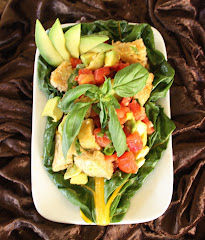
I love basil. It's one of those must have ingredients in my Italian style cuisine. I have fallen in love with this herb. Basil is used for medicinal, culinary and aromatic purposes. I just love the flavors.
Some of the varieties include: Sweet basil, Thai basil, Genovese basil, Lemon basil, Cinnamon Basil, Licorice basil, Lettuce Leaf Basil, and even Dark Opal Basil, to name a few!
Sweet basil is my favorite, it originates from Africa and tropical Asia and is now commonly known as European or French basil, as it is used widely throughout Mediterranean Europe in France, Spain and Italy. Sweet basil is also cultivated in North and South America. It is an annual herb, which grows up to two feet in height. Sweet basil has aromatic oval leaves and fragrant white or pink flowers, when exposed to heat.
I have a friend at the farmer's market on Saturdays who makes sure I get my fresh basil! This past weekend she had 10 lbs waiting for me! WHOA! That's a lot of basil. So here's what I did with it.
1. Basil Oil - basil pureed with oil and oil strained
2. Pure Basil Pesto - No Nuts (smooth)
3. Basil Pesto with Sundried Tomatoes and Pine Nuts (chunkier)
4. Basil Pesto with Artichoke Hearts and Black Greek Olives and Walnuts (chunkier)
Extra Virgin Olive Oil
Basil Leaves
Blend the basil leaves with as much oil as you want to preserve. Puree in food processor. Use a sieve and take a spoon to press leaves for pure oil. I took a smaller strainer over a funnel to remove any extra debris and bottled. Pure basil oil should be preserved in a refrigerator.
Pure Basil Pesto
Garlic Cloves
Pecorino Romano
Sea Salt
Extra Virgin Olive Oil
I always blend clean basil leaves in processor first. It's ok if the leaves are a little wet because the moisture does add to the smoothness of the pesto. The leaves should have stems removed, any brownish leaves removed and dried as much as possible. Then I add garlic, cheese, salt. And then the oil. I add just enough olive oil to blend and make smooth. Trick to keeping pesto green: add a small layer of olive oil on top after each usage. And you can freeze pesto in jars or even plastic resealable bags.
Basil Leaves
Garlic Cloves
Pecorino Romano
Sea Salt
Oil from Sundried Tomatoes
Extra Virgin Olive Oil if necessary
Sundried Tomatoes
Follow Pure Basil Pesto above and add sundried tomatoes after adding olive oil. PULSE for a few seconds until just blended. Leave a little chunky. If necessary you can add extra oil. This is a chunkier, less oilier pesto.
Basil Pesto with Artichoke Hearts and Black Greek Olives

Basil Leaves
Garlic Cloves
Pecorino Romano
Sea Salt
Extra Virgin Olive Oil
Greek Black Olives
Garlic Cloves
Pecorino Romano
Sea Salt
Extra Virgin Olive Oil
Greek Black Olives
Artichoke Hearts (drained)
Follow Pure Basil Pesto recipe above and add black olives and artichoke hearts after adding olive oil. PULSE for a few seconds until just blended. Leave chunky. If you need to add more olive oil for the right consistency you can add it now.
Enjoy with bread, pasta, spread for wraps and put on meats and fish just before serving. I also add a little pesto to a balsamic/olive dressing for extra flavor and thickness. Be creative and enjoy one of the most luscious summer herbs!












No comments:
Post a Comment